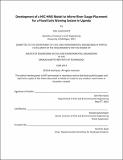Development of a HEC-HMS model to inform river gauge placement for a flood early warning system in Uganda
Author(s)
Kaatz, Joel Alan
DownloadFull printable version (3.011Mb)
Alternative title
Development of a hydrologic modeling system model to inform river gauge placement for a flood early warning system in Uganda
Other Contributors
Massachusetts Institute of Technology. Department of Civil and Environmental Engineering.
Advisor
Richard Schuhmann.
Terms of use
Metadata
Show full item recordAbstract
Communities in the downstream region of the Manafwa River Basin in eastern Uganda experience floods caused by heavy precipitation upstream. The Massachusetts Institute of Technology (MIT) has partnered with the Red Cross to develop a Flood Early Warning System (FEWS) that will alert downstream communities of imminent flooding. The first step in the development of the FEWS is to determine if the placement of a river gauge upstream from the existing gauge at Busiu Bridge will be capable of providing an early flood warning. A hydrologic model was developed using HEC-HMS software to determine if this warning is feasible and, if so, to facilitate the optimum placement of a gauge. The HEC-HMS model relates precipitation upstream to river flow downstream. Using an historical precipitation event, the model was calibrated to accurately predict the peak hydrograph caused by the precipitation event. The historical storm is characterized by precipitation evenly distributed over the entire watershed that produced a widespread rise in river height, as opposed to a defined flood wave that moves downstream. This storm served the purpose of calibrating the model, and the analysis of this storm concluded that a gauge upstream of Busiu Bridge will not provide flood warning for a storm characterized by precipitation evenly distributed over the watershed. The calibrated model was then used to predict the watershed response to a theoretical storm that is characterized by precipitation concentrated upstream. This upstream precipitation event is more likely to produce an upstream flood wave, and is common in the Manafwa River Basin. It was found that, for a storm with precipitation concentrated upstream, an upstream river gauge could be used to provide a flood warning. This study shows that the ability of an upstream river gauge to issue flood warnings is sensitive to the nature of a storm. The developed model produces hydrographs that can be used in a downstream hydraulic model to determine the optimum location for a river gauge in the Manafwa watershed, and the river conditions that would warrant a flood warning.
Description
Thesis: M. Eng., Massachusetts Institute of Technology, Department of Civil and Environmental Engineering, 2014. This electronic version was submitted by the student author. The certified thesis is available in the Institute Archives and Special Collections. Cataloged from student-submitted PDF version of thesis. Includes bibliographical references (pages 66-67).
Date issued
2014Department
Massachusetts Institute of Technology. Department of Civil and Environmental EngineeringPublisher
Massachusetts Institute of Technology
Keywords
Civil and Environmental Engineering.